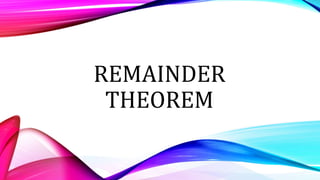Find Remainders Using the Remainder Theorem
•Download as PPT, PDF•
1 like•201 views
find the remainder of a polynomial using remainder theorem
Report
Share
Report
Share

Recommended
More Related Content
What's hot
What's hot (20)
Nature of the roots and sum and product of the roots of a quadratic equation

Nature of the roots and sum and product of the roots of a quadratic equation
solving quadratic equations using quadratic formula

solving quadratic equations using quadratic formula
Similar to Find Remainders Using the Remainder Theorem
Similar to Find Remainders Using the Remainder Theorem (20)
Delos-Santos-Analyn-M.-_Repoter-No.-1-Multiplication-and-Division-of-Polynomi...

Delos-Santos-Analyn-M.-_Repoter-No.-1-Multiplication-and-Division-of-Polynomi...
Recently uploaded
APM Welcome, APM North West Network Conference, Synergies Across Sectors

APM Welcome, APM North West Network Conference, Synergies Across SectorsAssociation for Project Management
Recently uploaded (20)
Kisan Call Centre - To harness potential of ICT in Agriculture by answer farm...

Kisan Call Centre - To harness potential of ICT in Agriculture by answer farm...
APM Welcome, APM North West Network Conference, Synergies Across Sectors

APM Welcome, APM North West Network Conference, Synergies Across Sectors
Incoming and Outgoing Shipments in 1 STEP Using Odoo 17

Incoming and Outgoing Shipments in 1 STEP Using Odoo 17
TataKelola dan KamSiber Kecerdasan Buatan v022.pdf

TataKelola dan KamSiber Kecerdasan Buatan v022.pdf
Science 7 - LAND and SEA BREEZE and its Characteristics

Science 7 - LAND and SEA BREEZE and its Characteristics
Micromeritics - Fundamental and Derived Properties of Powders

Micromeritics - Fundamental and Derived Properties of Powders
Presiding Officer Training module 2024 lok sabha elections

Presiding Officer Training module 2024 lok sabha elections
Contemporary philippine arts from the regions_PPT_Module_12 [Autosaved] (1).pptx![Contemporary philippine arts from the regions_PPT_Module_12 [Autosaved] (1).pptx](data:image/gif;base64,R0lGODlhAQABAIAAAAAAAP///yH5BAEAAAAALAAAAAABAAEAAAIBRAA7)
![Contemporary philippine arts from the regions_PPT_Module_12 [Autosaved] (1).pptx](data:image/gif;base64,R0lGODlhAQABAIAAAAAAAP///yH5BAEAAAAALAAAAAABAAEAAAIBRAA7)
Contemporary philippine arts from the regions_PPT_Module_12 [Autosaved] (1).pptx
Find Remainders Using the Remainder Theorem
- 2. Review: Divide using synthetic division to find the remainder. 1. p(x) = x3 – 7x – 6, D(x) = x - 4
- 3. 2. p(x) = 3x2 – 4x + 7, D(x) = x - 1
- 4. 3. p(x) = 3x3 – 2x2 - 7x + 6, D(x) = x + 1
- 5. 4. p(x) = 2x3 – 5 - 7, D(x) = x - 2
- 6. 5. p(x) = x3 + 5 , D(x) = x + 2
- 7. The Remainder Theorem When we divide a polynomial f(x) by x-c the remainder r equals f(c)
- 8. The remainder theorem is based on synthetic division, which is the process of dividing a polynomial f(x) by a polynomial D(x) and finding the remainder. This is written as , where f(x) is the dividend, Q(x) is the quotient, D(x) is the divisor, and R(x) is the remainder.
- 9. When we divide a polynomial f(x) by x- c we get: f(x) = (x-c)·q(x) + r(x)
- 10. But r(x) is simply the constant r (remember? when we divide by (x-c) the remainder is a constant) .... so we get this: f(x) = (x-c)·q(x) + r
- 11. Now see what happens when we have x equal to c: f(c) = (c-c)·q(c) + r f(c) = (0)·q(c) + r f(c) = r
- 12. Illustrative Examples: 1. 2x2 - 5x - 1 divided by x - 3 Equate x – 3 = 0 x = 3 + 3
- 13. Replace all x = 3 = 2(3)2 – 5(3) - 1 = 2(9) – 5(3) - 1 = 18 – 15 - 1 = 2 2x2 - 5x - 1
- 14. 2. 2x2 - 5x - 1 divided by x + 4 F(c) = -4 x + 4 = 0 - 4 = 2(-4)2 – 5(-4) - 1 = 2(16) – 5(-4) - 1
- 15. = 32 – (-20) - 1 = 51 3. f (x) = −x3 + 6x − 7 at x = 2 = -3
- 16. 4. f (x) = x3 + x2 − 5x − 6 at x = 2 = -4
- 17. 5. f (x) = x5 − 47x3 − 16x2 + 8x + 52 at x = 7 = 10